1970s Topps Grocery Tray Trivia
If you are a Wax Tray Collector, you’re in possession of some very desirable items! Barring a stupendous find of a long lost treasures trove of pre-1978 Wax Trays, there simply aren’t many Trays available. If a hidden hoard does exist, it would definitely be newsworthy since Topps really didn’t produce Trays in large quantities until the late 1970’s. What they did produce have become highly desirable due to both their scarcity as well as the extra layer of security, (provided by the cellophane seal) which offers additional protection against fraudulent wax pack resealers.
 Wax Trays were produced for grocery type accounts. Looking only at the 1970’s, most trays displayed similar characteristics; 3 wax packs, cellophane wrapper with either a green or brown (or red in 1980) price logo and a cardboard backboard. Both the cellophane and cardboard backing bore the standard Topps “wrapper coding”.
Wax Trays were produced for grocery type accounts. Looking only at the 1970’s, most trays displayed similar characteristics; 3 wax packs, cellophane wrapper with either a green or brown (or red in 1980) price logo and a cardboard backboard. Both the cellophane and cardboard backing bore the standard Topps “wrapper coding”.

If you were a retailer, you usually located the trays either in the candy aisle or right at the checkout. The consumer would purchase the trays because the tray offered multiple packs at a slightly discounted price.
Question #1 – This beautiful tray could potentially sell in the 5-figure range. What year is this from?
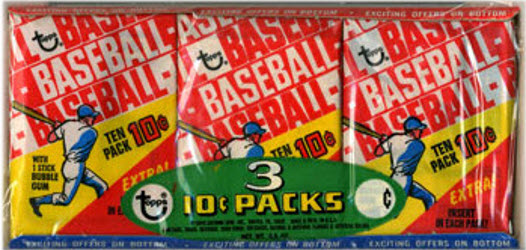
The correct answer is:
- 1970
- 1971
- 1972
- 1979
This grocery tray is a 1970 Topps Grocery Tray pack. Early 1970s trays are almost impossible to find. The reason why is fairly logical, there weren’t that many of them produced. Typically, toward the end of the season, Topps would use this method to get rid of remaining inventory, usually offering these into grocery stores (hence the name) at some small penny or so discount. By the end of each sport’s selling season, most kids who collected had already moved on to the next sport. Thus, these did not have a large demand.
Question #2 – What year is this grocery tray from? Here’s a hint – this set was the largest of the 1970s.
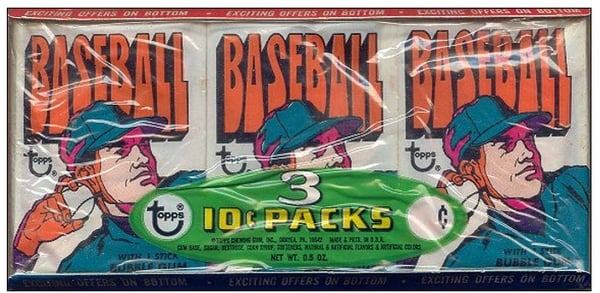
The correct answer is:
- 1970
- 1971
- 1972
- 1979
This grocery tray is a 1972 Topps Grocery Tray pack. If you notice, Topps used the same cardboard tray from 1970 – 1974 baseball. Topps was a manufacturing company that focused on keeping costs low and trying to maximize profits. If they could use old inventory, without losing profit they did so. Thus, they changed the trays once the price per packs changed, which they had started testing
Question #3 –This is a rare Topps Basketball Grocery Tray. What year is this from?
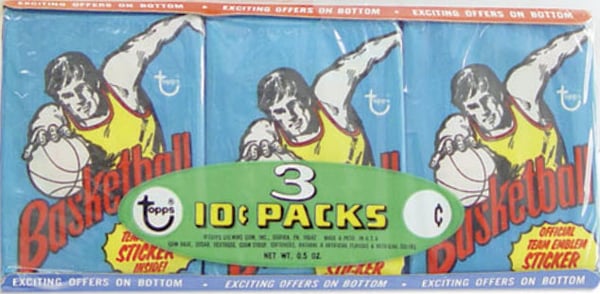
The correct answer is:
- 1971
- 1973
- 1975
- 1977
This grocery tray is a 1973 Topps Basketball Grocery Tray pack. Topps is known to have made trays in 1973, 1974, 1975 and 1978. There have been suggestions that Topps made trays in 1976, 1977 and 1979. If the last 3 do exist, none have surfaced in recent memory. It would seem highly unlikely for the 1976 to exist as this would have required a 1-time, different size tray and Topps preferred standardizing inventory production during the 1970s.
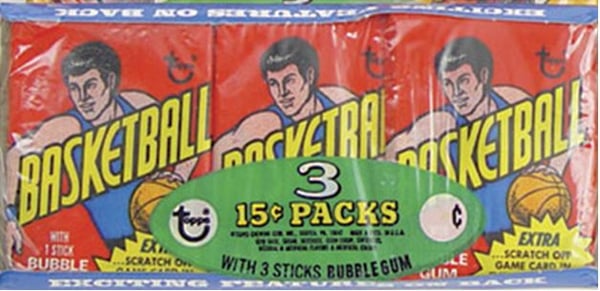
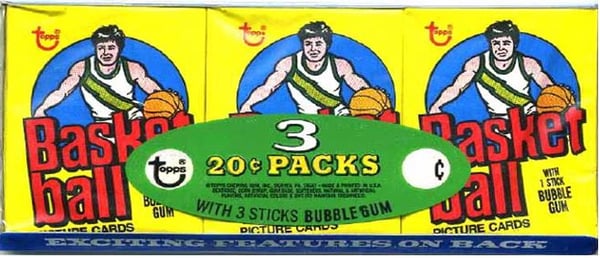
Question #4 - This grocery pack had 2 different Topps wrapper variations. What is the year of this grocery tray?
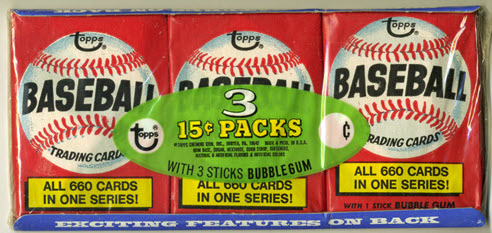
The correct answer is:
- 1971
- 1974
- 1976
- 1978
The 1976 Topps Baseball Grocery Trays were actually available with 2 different wrapper types. The first, this one had the “All 660 Cards in One Series” variation. The second variation simply stated, “1976 Series.”
Many people get confused with the first variation as it looks just like the 1974 wrapper. There are multiple ways to tell the differences though on the face of the tray. First, the 1974 cardboard tray has a top lip that is red and bottom that is blue while the 1976 is blue for both. Next, is the pricing. 1974 is 10 cents a pack and 1976 is 15 cents. Last is the wrapper variation. 1974 show “Bonus Team Checklist Inside.”
Question #5 - This is the 1974 Topps Baseball Grocery Tray pack. If you were to have purchased this directly from Topps in 1974, there were 48 trays in one case. What would you have paid for that case?
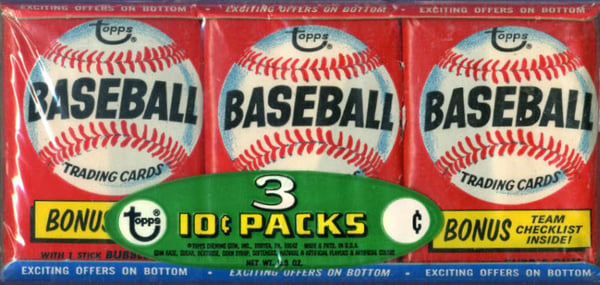
The correct answer is:
- $9
- $18
- $27
- $36
The cost of a case of 1974 Topps Baseball Grocery Tray packs was $9. Since there were 48 trays in the case, your cost per tray was 18.75 cents each. If you were reselling these at the retail price at the time, you would be making about 11 cents per tray.

Now fast forward to today… these are rarely seen. Perhaps one comes up for sale each year or every other year. These could sell in the $3-$5 thousand range. So… if you were to find a case today, it would sell for perhaps as high as $250,000! …which would be an incredible return on a $9 purchase.
Question #6– Did you know that Topps made non-sport Grocery Tray packs as well? This is the Battlestar Galactica version. What year was this from?
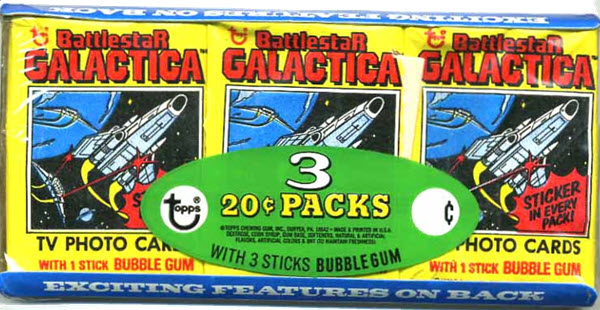
The correct answer is:
- 1975
- 1976
- 1977
- 1978
The Topps Battlestar Galactica Grocery Tray Pack was from 1978. Interestingly, this shares the same cellophane wrapper and pricing as the 1978 Topps baseball but not the 1978 Topps football, which suggests this was printed in the time between these production runs. Topps also produced a Superman non-sport tray packs too.
Question #7–This case held 48 Grocery Tray Packs from what year?
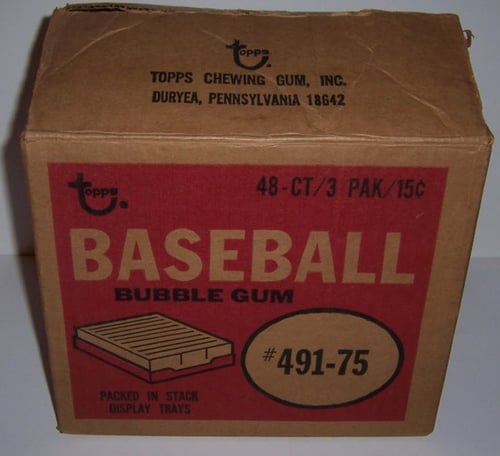
The correct answer is:
- 1971
- 1973
- 1975
- 1977
This is a 1975 Topps Grocery Tray case. It held 48, 3-card packs, which would have been the equivalent of 4 full wax boxes. Think about all the Brett and Yount rookies this may contained.
Bonus: Question #8– This is a rather scarce Football Grocery Tray. What year is this from? Hint: The Steve Largent rookie can be found in these packs.
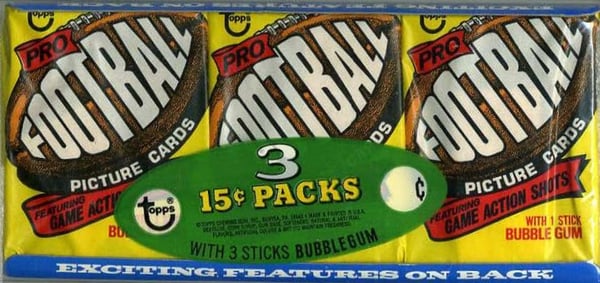
The correct answer is:
- 1975
- 1976
- 1977
- 1978
This grocery tray is a 1977 Topps Football Grocery Tray pack. It is believed that Topps made Football tray packs for each year during the 1970s. Interestingly, they did not do the same for basketball or hockey. Thinking like a Topps executive during the 1970s, this makes sense. Football was always the 2nd most popular sport and could support “end of season” sales, albeit at reduced rates. It has been assumed that the annual production runs ran like this, baseball kicked off the new year, followed by football and then basketball and hockey. Thus, the tray production(when produced), would follow too.
If you like this bit of trivia, share it with your friends!
Want to continue reading? Here are a few posts you might find interesting:
- 1970 Topps Baseball: Everything You Want To Know
- 1971 Topps Baseball: Everything You Wanted To Know
- A Look Back At The 1986-87 Fleer Basketball Set
- 1989 Ken Griffey Jr. Rookie: The Improbable Foresight of Upper Deck
- Ichiro Suzuki Rookie: What is the value of "Once in a Lifetime Cards?"
- Investing In Fleer Michael Jordan Cards? Here Is What You Need To Know

